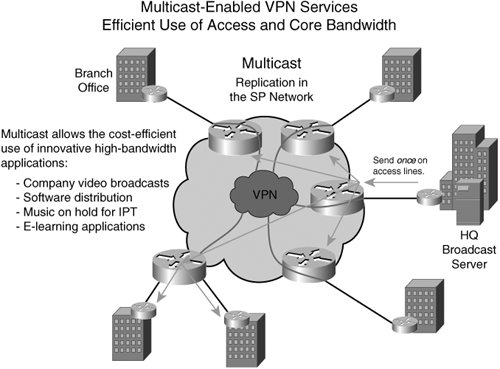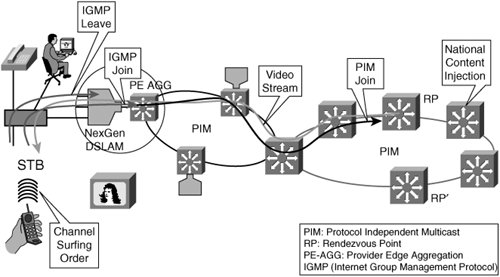MPLS Multicast VPN Applications and Examples
| In the finance sector, an opportunity to reduce the cost of operations exists via the application of hoot 'n' holler onto an existing IP infrastructure. Hoot 'n' holler provides always-on multiuser conferences without requiring users to dial in to a conference bridge. The three major components of a hoot 'n' holler system are transport, bridging, and station apparatus. In most cases, transport is accomplished using dedicated point-to-point circuits provided by a network service provider. Typically, a branch office (financial model) or a station on a hoot 'n' holler network consists of a four-wire, push-to-talk (PTT) handset and a loudspeaker. Standalone speakers are used as well as combination phone/speaker units. When more phones and speakers are required, common equipment (CE) is necessary to distribute the audio and power feeds to the stations. Because the transmit and receive paths are always separate in a four-wire circuit, you must mix the audio (local transmit-out and distant-end receive-in). The CE also provides this functionality. Currently, most hoot 'n' holler customers pay for separate leased line charges from a common carriersuch as their telephone service providerto transport their hoot 'n' holler communications to remote branch offices. This recurring monthly charge is usually significant; some larger firms spend more than $2 to $3 million per year just to support hoot 'n' holler feeds. As these networks have grown from four-wire party lines to global conferencing networks, the sophistication and complexity have increased dramatically. Hoot 'n' holler has proven to be the most cost-effective application for disseminating information across a company in real time. Other applications for MVPN include e-learning via IPTV, videostreaming, and music on hold for IP telephony. Figures 10-6 and 10-7 provide an overview of MVPN-enabled services and the use of multicast for IPTV. In Figure 10-7, we assume 30,000 additional ADSL subscribers per month; this assumption can be used for both retail and wholesale service offerings. Dynamic multicast construct is linked to channel surfing or zap time sequences. Figure 10-6. Multicast-Enabled VPN Services: Efficient Use of Access and Core Bandwidth Figure 10-7. Optimizing Video Distribution Dynamic Multicast |
EAN: 2147483647
Pages: 162